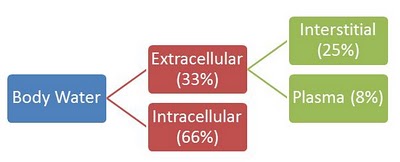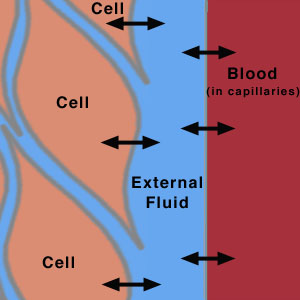Total Body Water (TBW)
You know water is the major thing that living things are made of and as a nurse, you’re going to need to make sure your patients hydration levels are appropriate. So, sometimes we need to estimate what is the total amount of water a person is made of. The first thing we need to do is convert pounds to kilograms. Why is body weight expressed in kilograms? Because the metric system is very clever: One liter of fluid weighs one kilogram.
TBW = 60% x Body Weight in kilograms
Let’s pretend someone weighs 154lbs. First we convert pounds to kg:
154lbs X 1 kg/2.24 lbs = 68.9kg.
Normally you would have used your calculator to do this but I beg you estimate what the right number should be. If we divide 2 into 150, that would be 75kg. If we divide by 2.2, we get 70kg. So anyway, the answer is very close to that.
TBW: 0.6 x 68.9kg is 41kg which means we have 41L TBW.
Distribution of water within the body
Intracellular Fluid (ICF): The amount of water that’s inside our cells accounts for 2/3rds of our TBW.
Extracellular Fluid (ECF): The amount of water that surrounds our cells accounts for 1/3 of our TBW. ECF is also known as interstitial fluid because it’s the fluid in between the cells.
Mnemonic to help you remember which is 1/3rd and 2/3rd: ECF and ICF. E comes before I in the alphabet, so E is 1/3rd and I is 2/3rd.
ICF = 2/3 X TBW. For example, 2/3 x 41L = 27L
ECF = 1/3 X TBW. For example, 1/3 x 41L = 14L

Extracellular fluid in detail
Now to make things slightly more complicated, there’s really three types of ECF:
Tissue fluid: 2/3rd of ECF
Blood plasma: 1/3rd of ECF
Transcellular fluid: Often not calculated as a fraction of the extracellular fluid, but it is about 2.5% of TBW.
Transcellular fluids are ECF that are contained in specific anatomical areas of the body, within epithelial lined spaces. For example, CSF surrounds your brain and spinal cord and it’s contained in your skull and your spinal column. Sinovial fluids are the slippery fluids contained within the sinovial joints such as the knee, elbow, and between the tibia and femur. We also have slippery serous fluids in our abdominal and chest cavities, known as peritoneal fluid and pleural fluid, respectively. The fluid inside your eyeball is intraocular fluid (sometimes called vitreous humour). These fluids don’t acocunt for too much. For example the CSF is only about 100ml.
Water can flow from ICF to ECF. If you injure your knee, fluid starts to flow from your blood stream into the sinovial fluid and starts to build up. Hydrocephalus is when too much fluid from the blood stream is building up in the CSF. Ascites is the buildup of the peritoneal fluid (abdominal edema).
Total Blood Volume (TBV)
Blood is made up of blood cells and blood plasma.
TBV = 8% x Body Weight (kg). Remember, we can calculate volume from mass without a problem because that’s the beauty of the metric system (1.0kg water = 1.0L water)
So our reference person has 0.08 x 70kg = 5.6kg = 5.6L of blood.
If you go to donate blood, they take about a 1/10th of a liter of blood. Then they tell you to drink some orange juice, eat a cookie and you’ll be okay. How much blood would you have to have to have lost for them to do an IV drip? You would have had to lose more than a liter of your blood volume, which is about 20% of your blood.
Distribution of Electrolytes
Remember electrolytes are ions. There are very important differences between the electrolytes inside and outside the cell which we will talk about in detail in the future. This chart says ICF AND EXF and lists the electrolytes found most often.
| ICF | ECF |
|---|---|
| K+ | Na+ |
| Mg+2 | Ca+2 |
| PO4 -3 | Cl- |
| Protein – (due to negatively charged amino acids in proteins) | HCO3- |
Proteins in general have a weak negative polarity. The fact that we see a lot of Na and Cl is because that’s salt. The fact that we see a lot of Ca and HCO3 is because Ca(HCO3)2 is bicarbonate.
Distribution of ions in body compartments
| ICF/Intracellular (mEq/L) | Tissue Fluid / Interstitial (mEq/L) | Blood Plasma (mEq/L) | |
|---|---|---|---|
| Cations | |||
| Na+ | 10 | 147 | 142 |
| K+ | 140 | 4.0 | 5.0 |
| Ca++ | 5 | 2.5 | 5.0 |
| Mg++ | 27 | 2.0 | 3.0 |
| Anions | |||
| HCO3- | 10 | 30 | 27 |
| Cl- | 25 | 114 | 103 |
| PO4– | 80 | 2.0 | 2 |
| SO4- | 20 | 1.0 | 1 |
| Organic acids | – | 7.5 | 6 |
| Proteins | 47 | 0 | 16 |

These are the actual quantitative numbers. The units are in milliequivalents per liter (mEq/L.)
Notice there’s a high amount of potassium (K+) inside the cell. Notice there’s a high amount of sodium (Na+) outside the cells. Notice the chemical composition of tissue fluid and blood are VERY SIMILAR because tissue fluid comes from capillaries anyway. One major exception are with the proteins. The tissue fluid has no protein but in the blood there are plasma proteins secreted by your liver cells.






